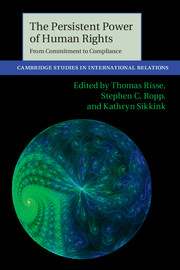Book contents
- Frontmatter
- Contents
- Figures
- Tables
- Contributors
- Preface
- Part I Introduction and stock-taking
- Part II Conceptual and methodological issues
- Part III From ratification to compliance
- 7 The normative context of human rights criticism
- 8 The United States and torture
- 9 Resisting the power of human rights
- 10 The “Arab Spring” and the spiral model
- Part IV From commitment to compliance
- References
- Index
8 - The United States and torture
Does the spiral model work?
Published online by Cambridge University Press: 05 March 2013
- Frontmatter
- Contents
- Figures
- Tables
- Contributors
- Preface
- Part I Introduction and stock-taking
- Part II Conceptual and methodological issues
- Part III From ratification to compliance
- 7 The normative context of human rights criticism
- 8 The United States and torture
- 9 Resisting the power of human rights
- 10 The “Arab Spring” and the spiral model
- Part IV From commitment to compliance
- References
- Index
Summary
Scholars of international relations have long said that the real test of international law and new norms is their ability to influence the actions of even the most powerful states. Thus, no discussion of compliance with human rights law would be complete without a consideration of the case of the United States. In particular, I will focus on US non-compliance with the prohibition on torture and cruel and degrading treatment during the administration of George W. Bush. Did domestic and international human rights pressures have any influence on this case? In particular, in the chapter, I explore whether the “spiral model” description and explanation of human rights change in our study The Power of Human Rights (PoHR) is useful to understand the US move from non-compliance to greater compliance with the prohibition on torture.
At first glance, the US case would appear to confirm realist expectations that powerful states are able to disregard international rules at will without significant cost. When carefully examined, however, the US case offers a more complex but not necessarily a more optimistic story. US policy-makers were in fact intensely aware of domestic and international pressures, and in particular, the possibility of domestic prosecution under US statutes implementing international human rights law; many of their actions, including the infamous torture memos, were partially driven by this awareness. But such awareness did not lead to greater compliance until after the Bush administration left office.
- Type
- Chapter
- Information
- The Persistent Power of Human RightsFrom Commitment to Compliance, pp. 145 - 163Publisher: Cambridge University PressPrint publication year: 2013
- 38
- Cited by

